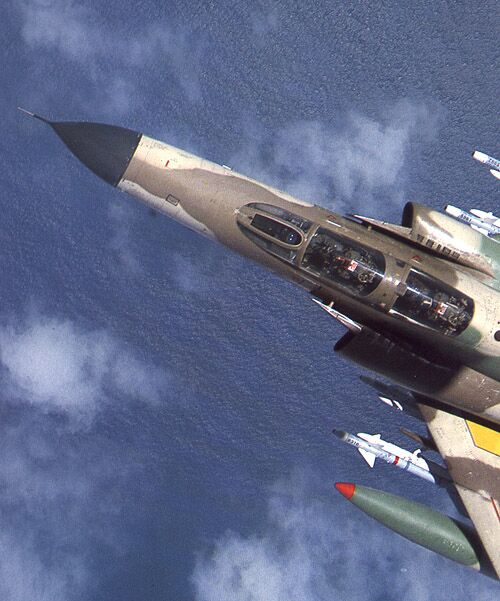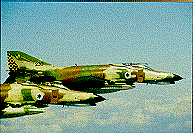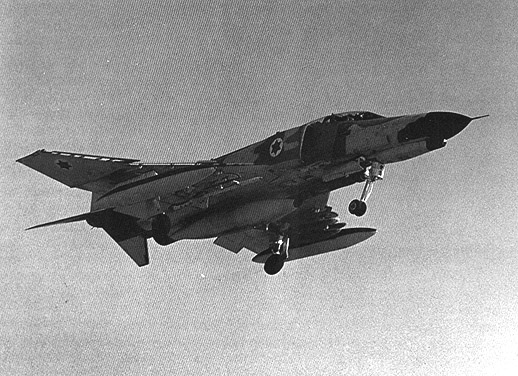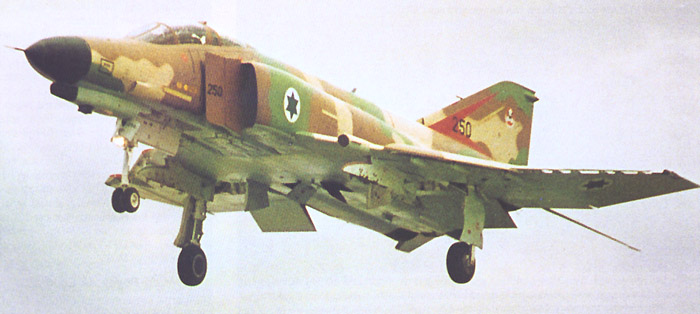

For almost 20 years, from 1960 to 1980, the Phantom II was the top fighter of
the world, against which all other combat aircraft were measured. By the time
production of the type ended in 1979, over 5,000 Phantom IIs had been built
around the world. Planned from 1953, the prototype XF4H-1 was first flown on May
27th 1958, having been developed as a carrier based interceptor for the U.S.
Navy. Delievered for service from February 1960, the first versions were the
F-4A and F-4B for the Navy, followed by the C,D and E for the U.S. Air Force.
The F-4E was the main export version and the first true multi-role variant, with
an internal 20mm chin mounted cannon absent on previous versions. The Phantom
was the main U.S. fighter in the Vietnam war and served in numerous other air
forces around the world, including those of Britain (RAF and Navy, built in
Britain), Germany, Japan, Turkey, Egypt and Iran.
Israel had first expressed
an interest in acquiring the Phatom in 1965, but the U.S. was not yet willing to
sell the fighter to Israel and agreed to provide A-4 Skyhawks instead. After the
1967 Six Days War Israel watched with growing alarm the rapid rearmament of Arab
air forces with frontline Soviet fighters and sought to renew its own fighter
fleet. France, its major arms supplier until then, had embargoed all sales to
Israel after a 1968 commando raid on Beirut's airport. Israel therefore once
again turned to the U.S. in hope of acquiring the F-4 and in a meeting with
Israeli prime minister Levy Eshkol in January 1968, president Lyndon Johnson
finally agreed to look favorably on a Phantom sale to Israel. In December 1968
the "Peace Echo" deal was signed for the provision of 44 F-4Es and 6 RF-4Es to the IAF and on March 25th 1969 Israeli crews begun
training on the new fighters. Although the War of Attrition was still going on
at the time, the IAF sent its best pilots and navigators to the U.S., headed by
the two future F-4 squadron commanders : Avihu Ben-Nun and Shmuel Hetz. The
Israeli delegation returned to Israel during August and on Friday, September
5th, the first Israel Phantoms landed at Hazor AFB. The four planes, wearing an
IAF color scheme but still carrying their American markings, joined the new
201st "Ha'ahat" (The One) squadron, commanded by Shmuel Hetz. Delieveries
continued at a rate of 4 a month and on October 23rd the 69th "Patishim"
(Hammers) squadron was reformed at Ramat-David, headed by Avihu Ben-Nun. The
type entered service as the "Kurnass" (Sledgehammer), the last aircraft arriving
in May 1971. With the War of Attrition raging along the Suez
Canal, the new Phantoms and their crews were only given a short adjustment
period before being thrown into the fighting. The first operational Phantom
sortie took place on October 5th 1969, a combat air patrol in the southern Sinai
lead by the 201 squadron commander Shmuel Hetz. The Phantoms were a
technological and operational leap for the IAF and with their unparalleled load
capacity, long range and missile weaponry, were rapidly introduced into the
IAF's day to day operations. On October 22nd, only 8 weeks after their arrival,
the Phantoms flew their first ground attack mission, against an Egyptian SA-2
battery near Abu-Sweir. In November 1969 the IAF initiated operation "Helem"
(Shock), in which Phantoms routinely conducted low level supersonic passes over
Cairo in order to demonstrate the IAF's ability to operate unhampered over
Egypt. The first such sortie took place on November 4th and these flights
continued until January 1970. On January 29th 1970, after a lone Syrian MiG-21
managed to infiltrate Israeli airspace and conduct one such flight over Haifa,
Israel responded by sending Phantoms on similar missions over 5 major Syrian
cities. On Nomvember 11th 1969 the Phantom scored its first kill, an Egyptian
MiG-21 downed by Ehud Hankin and Eyal Ahikar from 69 squadron, flying a 201
squadron aircraft. The War of Attrition saw the first major introduction of Soviet SAMs into the fighting
between Israel and its Arab neighbors and a large part of IAF operations at the
time were directed against these missiles and their batteries. The Phantoms were
the spearhead of the IAF's attempt to destroy these SAMs, an attempt that lasted
right up to the end of the war in August 1970. Large scale attacks took place
during late November and on December 25th 1969, both resulting in the
destruction of the entire Egyptian missile array. These losses were however,
rapidly made good by Soviet assistance and the SAMs soon returned to pose a
threat to the IAF. Such was the routine of IAF Vs. SAM operations throughout
1970. On November 17th 1969 F-4s attacked a pair of Jordanian radar stations
which had provided radar coverage of Israel to the Egyptians and Syrians. Both
stationed were destroyed for the loss of a single Phantom, once again flown by
Ehud Hankin.
With the War of Attrition raging along the Suez
Canal, the new Phantoms and their crews were only given a short adjustment
period before being thrown into the fighting. The first operational Phantom
sortie took place on October 5th 1969, a combat air patrol in the southern Sinai
lead by the 201 squadron commander Shmuel Hetz. The Phantoms were a
technological and operational leap for the IAF and with their unparalleled load
capacity, long range and missile weaponry, were rapidly introduced into the
IAF's day to day operations. On October 22nd, only 8 weeks after their arrival,
the Phantoms flew their first ground attack mission, against an Egyptian SA-2
battery near Abu-Sweir. In November 1969 the IAF initiated operation "Helem"
(Shock), in which Phantoms routinely conducted low level supersonic passes over
Cairo in order to demonstrate the IAF's ability to operate unhampered over
Egypt. The first such sortie took place on November 4th and these flights
continued until January 1970. On January 29th 1970, after a lone Syrian MiG-21
managed to infiltrate Israeli airspace and conduct one such flight over Haifa,
Israel responded by sending Phantoms on similar missions over 5 major Syrian
cities. On Nomvember 11th 1969 the Phantom scored its first kill, an Egyptian
MiG-21 downed by Ehud Hankin and Eyal Ahikar from 69 squadron, flying a 201
squadron aircraft. The War of Attrition saw the first major introduction of Soviet SAMs into the fighting
between Israel and its Arab neighbors and a large part of IAF operations at the
time were directed against these missiles and their batteries. The Phantoms were
the spearhead of the IAF's attempt to destroy these SAMs, an attempt that lasted
right up to the end of the war in August 1970. Large scale attacks took place
during late November and on December 25th 1969, both resulting in the
destruction of the entire Egyptian missile array. These losses were however,
rapidly made good by Soviet assistance and the SAMs soon returned to pose a
threat to the IAF. Such was the routine of IAF Vs. SAM operations throughout
1970. On November 17th 1969 F-4s attacked a pair of Jordanian radar stations
which had provided radar coverage of Israel to the Egyptians and Syrians. Both
stationed were destroyed for the loss of a single Phantom, once again flown by
Ehud Hankin.
By the end of 1969, the War of Attrition had reached a
stalemate, with mutual exchanges of fire taking place across the Suez Canal. In
a bid to break the stalemeate, the IDF had decided to commence deep penetration
strikes against the heart of Egypt, further demonstrating Egyptian vulnerability
and pushing the Egyptian leadership towards a ceasefire. On January 7th 1970
Israel launched operation "Priha" (Bloom) with attacks by Phantoms against army
bases around Cairo. IAF F-4s returned on more strikes on January 13th, 18th and
23rd and on February 8th the IAF begun attacking Egyptian Air Force bases.
During this last attack a 69th squadron F-4 flown by Aviam Sela and Shabtay
Ben-Shua scored the squadron's first kill by downing an Egyptian MiG. As Soviet
assistance continued to pour into Egypt, the Egyptians attempted to disrupt
these strikes by positioning their SAMs along the IAF's penetration routes.
Israeli F-4s, along with their Dassault Mirage escorts,
nonetheless continued their attacks against both the SAM sites and against other
Egyptian military targets, such attacks taking place on average once every ten
days. On February 26th F-4s attacked two SA-2 sites when Egyptian MiGs attempted
to intercept them. In the onsueing dogfight, three MiGs were downed by the
Phantoms' Mirage escort. The strikes continued during
March, 13 MiGs downed throughout the month.


F-4 Phantom II - The Bat Squadron
On July 18th 1970 the IAF resumed its missile suppression strikes, this time
with new ECM pods supplied by the USA. American experts had suggested a new
method of countering the SAMs, high altitude tight formations that would form an
electronic barrier against the missiles. This tactic however, was completely
wrong and coupled with the ECM pods' inefficiency proved disasterous to the
attacking aircraft. Shmuel Hetz, commander of the 201st squadron, was killed by
a direct SAM hit to his Phantom, his weapons system officer (WSO) parachuting
into captivity. Another Phantom was also hit but managed to land at a nearby IAF
air base. With Hetz replaced by Ran Peker, Phantom strikes continued. A fifth
aircraft was lost to SAMs on August 3rd, while another was flown back to base by
its WSO after the pilot suffered severe injuries.
Once again the War of
Attrition had reached a statelment, with Israel unable to effectively deal with
the Egyptian SAMs, and Egypt suffering severe damage and unable to initiate any
action of its own. The success of their air defence systems in hampering IAF
operations inspired the Soviets present in Egypt to become more envolved in the
fighting. This eventualy led to a direct clash between Israel and the USSR which
took place on July 30th 1970 and resulted in the
downing of 5 Russian MiG-21s, two at the hands of Israeli Phantoms. Subsequent
fears of Soviet and American involvement in the fighting propelled both sides to
reach an agreement and on August 7th 1970 Israel and Egypt signed an armistice
agreement, bringing an end to the War of Attrition. The ceasefire agreement had
called for Egyptian SAMs to be positioned no closer than 30km from the Suez
Canal, but flagrantly violating the agreement, Egypt nonetheless advanced dozens
of its SAM batteries and hundereds of its AAA guns into the Canal zone, setting
the stage for the next Israeli-Egyptian conflict, three years later.
 back to the IDF/AF page
back to the IDF/AF page